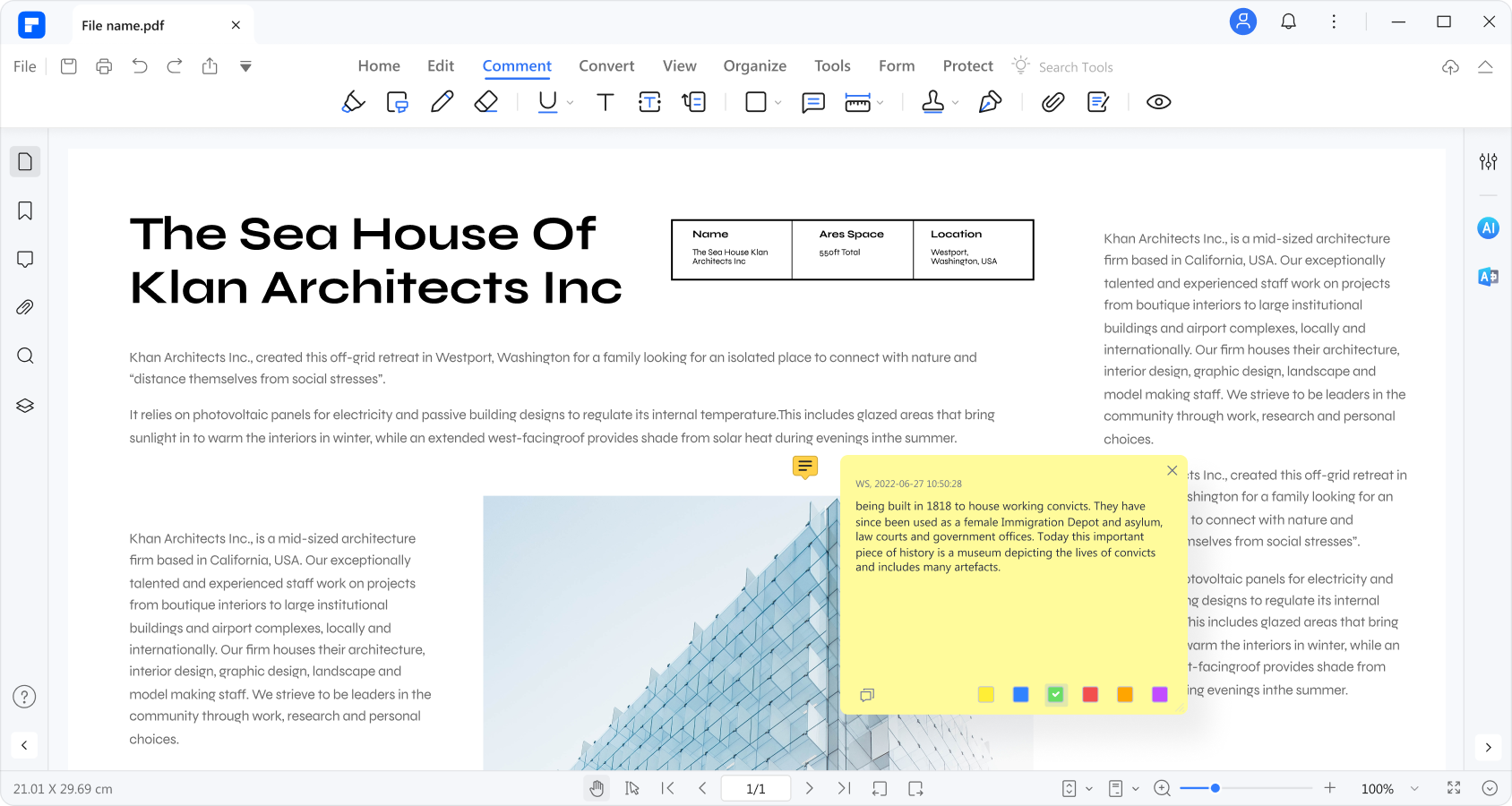When studying, especially when there are so many topics, simply reading a textbook is not enough. You have to jot down notes. It's an effective strategy for retaining the information. However, when not done properly, it will cause little to no improvement. So, how do you take notes from a textbook? This article will teach you that by delving into the do's and don'ts.
In this article
Part 1. How To Take Notes From a Textbook
Taking effective notes from textbooks is a key skill for academic success. Here are some tips to get you started:
Tip #1. Use a Note-Taking App
In today's digital age, many textbooks come in PDF format, allowing streamlined note-taking. You can use pen and paper for traditional note-taking. But why do that when there's an easier alternative? “How to take notes from a textbook more easily?” you ask. You can use programs like Wondershare PDFelement, which lets you annotate the PDF directly.

Wondershare PDFelement's Comments feature lets you add notes. You can export these notes to a new PDF, which you can convert to a Markdown file. You can then convert the Markdown to a mind map to make your notes more effective.
Follow these series of steps to do that:
- Open the digital textbook using Wondershare PDFelement.
- Click Comment > Notes. Take notes. You can add as many notes as you can.

- Click Create Notes > Apply. Wondershare PDFelement will create a new PDF with the notes attached to it.

- Click Convert > More > To Markdown > Convert.

- Find the markdown file and open it with a tool like Wondershare EdrawMind to convert it to a mind map.

Tip #2. Create Mind Maps
How to make notes from a textbook that’s easy for your brain to interpret? Remember that using visual aids is a great technique for studying. Your brain processes visuals a lot faster than it can process text. That's because visuals straight up tell you what they're trying to present. Meanwhile, you need to read a text word for word before you can understand the context. That said, we recommend using mind maps.
Mind maps provide a visual overview of the subject matter. It helps you understand relationships between different ideas and topics without reading many words. By incorporating mind maps into your note-taking process, you can transform dense textbook content into a dynamic and accessible format that promotes deeper learning and understanding.
Tip #3. Organize Your Notes
How do you take notes from a textbook effectively? One common mistake is doing it excessively. If you do this, you are just rewriting the textbook. It does not help you save time and cover more subjects, which is why you want to take notes.
What to do then? Select the really important parts and jot them down. Some information is obscure, and some topics are too niche. You can skip these and focus more on the information that really matters.
Use bullet points and outlines to make it easier for you to understand and review.
Tip #4. Don’t Copy Verbatim
Some people are inclined to copy what's in the textbook exactly how it was written. This is not how you take notes from a textbook. It’s a bad note-taking strategy Most of the time, it will not make you understand the subject.
Instead, what you should do is read the topic in the textbook and then rewrite the important parts using your own words. Do not look at the textbook and try to rely solely on your memory. After rewriting, look at the textbook to check if you understood it correctly. This method ensures that you have a firm grasp of the topic.
Tip #5. Include Examples
Textbooks often include examples. Make sure to always include them in your notes from textbooks. Examples provide clarification and illustrate abstract concepts or theoretical ideas presented in the textbook. They make complex topics easier to understand by showing how the concepts apply in real-world situations.
If there are no provided examples, try to create one yourself. It encourages critical thinking and application of knowledge, which is great for learning. This is also an interactive exercise that will prevent you from dozing off.
Tip #6. After Making Textbook Notes, Review Them
Do not stop at learning how to make notes from textbooks. Learn how to review them too. This is one thing that some people forget to do or never do. Look back at the textbook to confirm the information that you have written. Ensure everything is right. And do not take notes then call it a day. You are not sure you retained the information you have read. Scan your notes a couple of times.
You should also revise your notes. Again, try writing them relying only on your memory. Then, correct the things you remembered wrong. It's like a dry run for the test. This will help you have a mastery of the subject in no time.
Part 2. How Do You Take Notes From a Textbook: What Not To Do
Let us now talk about the things you should avoid doing when you are taking notes from textbooks.
1. Do Not Ignore Graphs and Charts

Charts and graphs in a textbook can significantly aid in understanding complex concepts by visually representing data and relationships. They offer a clear and concise way to interpret information, making it easier to grasp patterns and trends. By paying attention to charts and graphs, you can gain insights that may not be as apparent from textual explanations alone.
2. Avoid Passive Reading
Passive reading involves simply scanning through the text without actively engaging with the material. This approach can hinder effective learning for several reasons. Firstly, passive reading often leads to superficial understanding. In other words, you don't fully comprehend the nuances or complexities of the content. Without active engagement, it's also easier to become distracted or lose focus.
Additionally, passive reading fails to stimulate critical thinking or analytical skills. These two are essential for deeper understanding and application of knowledge.
3. Do Not Rush
You do not need to include every single detail in your notes. But that does not give you an excuse to rush your note-taking. Do not skip pages and paragraphs. That can cause you to miss critical information. Take the time to read or at least scan every part of the textbook to find essential information. Quality note-taking requires careful attention to detail and thoughtful synthesis of information.
4. Do Not Take Down Notes From Textbooks While Distracted

Before starting your note-taking session, ensure you have a clear mind so you can focus on the task. Taking notes when you're distracted or easily distracted can lead to incomplete or inaccurate information being recorded. You might miss key concepts, resulting in notes that are of low quality or even incorrect.
Additionally, attempting to take notes while distracted can be frustrating and inefficient. It may take longer to process information and organize your thoughts. Worst comes to worst; you will not understand what you are reading, causing you to read a sentence over and over again.
By minimizing distractions and maintaining focus, you can produce more effective notes that support better learning outcomes.
5. Don’t Depend Solely on the Text in the Textbook

While the textbook is a valuable resource, don’t depend solely on the text for information. There might be critical information that the textbook has failed to include. Other sources may also be able to provide you with better examples or explanations that are easier to understand. That said, supplement your notes with additional resources. Check out online articles, videos, or supplementary readings to gain a more comprehensive understanding of the topic.
Conclusion
Copying what is written in the textbook is the easy way, but not the proper way to take notes. If you do this, there's a high chance that you will not understand what you are studying. Instead, you should read the text, then rewrite it with your own words. If possible, do not look at the textbook while doing these to ensure you understand the subject. Review and correct it after.
Textbooks are also available now as PDFs. You can use Wondershare PDFelement to open them and write notes. That's more efficient than keeping your notes on a physical notepad or a piece of paper. Wondershare PDFelement can also export the PDF to Markdown, allowing you to quickly create mind maps.

 G2 Rating: 4.5/5 |
G2 Rating: 4.5/5 |  100% Secure
100% Secure



